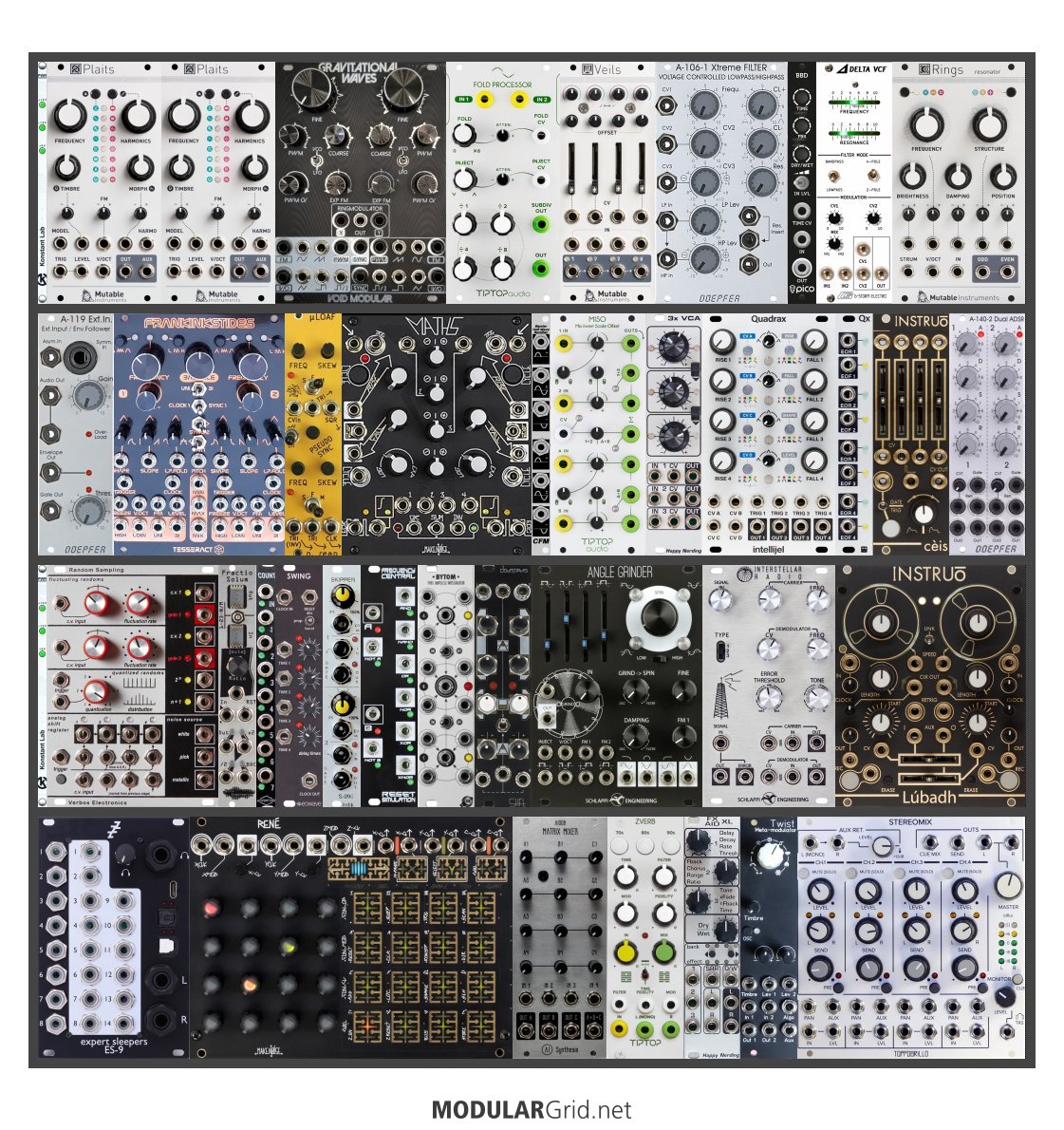OK...I opted to show what a full-on modular for the sort of soundtrack work you do would turn out. This build is based on a pair of Tiptop Mantis cabs with their connecting hinge add-on.

Yep, it's much bigger than the original, but the objective here is to show an "optimal final configuration", which should give you a decent aiming point for that.
Top row: Two Plaits, then a Void Gravitational Waves, which is a complex dual VCO with its own ring modulator. The Fold Processor allows you to mangle the waveforms of these, even via crossmixing the waveforms, plus it also gives you a subbass divider. A Veils then allows VCA level control and/or mixing of all of this. The A-106-1 VCF (actually a dual VCF, as this is based on the MS-20 Sallen-Key pair) is tandemmed with an Erica Pico BBD so that you can easily insert this delay into the A-106-1's resonance path, with some very interesting results! Then I put in a G-Storm Delta VCF (a copy of the Korg Delta/Poly-61 VCF) for more pad-like behavior, and after this, the Rings.
Second row: This is your modulation row, although the external preamp/envelope follower is at the left end and potentially feeds into the top row...but you can also use this as a modulation source by sending it audio and using only the envelope follower to track the incoming dynamics. The Frankentides is an expanded dual Tides clone for long LFO curves. The uLoaf is two somewhat conventional LFOs with the usual Noise Reap crossmodulation weirdnesses. After this is Maths, then a dual rectifier which can force over-zero or under-zero modulation signals out of the usual bipolar ones. The MISO is a modulation manipulator in addition to a DC-coupled mixer with CV tricks. And after that, three linear VCAs which can also CV-controlled mix modulation signals. The Quadrax handles the AR/ASR envelopes, with its Qx expander allowing cascaded behavior as well as the ability to trigger other actions. Then for ADSR envelopes, I put in an Instruo Ceis for CV-controlled envelopes, and a Doepfer A-140-2 for fixed-level ADSR envelopes.
Third row: The Verbos Random Sampling module gives you a comprehensive array of random signals and noise colors, plus it also contains an analog shift register that can also function as a quad sample and hold. After this is an array of modules for messing with timing signals coming off of the ES-9: a CVable clock divider/multiplier, a step counter, quad gate swing, dual probabilistic pulse skipper, a dual Boolean logic module, Xaoc Bytom for combining clock/pulse signals, and a dual window comparator for picking gates off of modulation curves as well as a "squaring" waveshaper. Following this are two VERY destructive audio mangling modules from Schlappi Engineering, then the Instruo Lubadh sampler, which is positioned so that it's easily usable with the mixer.
Bottom row: There's the ES-9, then a Make Noise Rene which can function both as a sequencer AND a touchplate controller. An AI Synthesis matrix mixer allows you to manually alter CV/mod routings, mixing, and levels. Then the effects: a Tiptop Zverb, Happy Nerding's FX Aid XL, and a clone of the Mutable Warps module designed to fit into a 6 hp space. The Toppobrillo Stereomix2 is the main system mixer, with VCA control over levels on each input, plus CV over AUX sends and panning as well as muting on each input channel. This also gives you a "cue" channel in case something needs adjustment on the fly, plus a stereo AUX return. This mixer allows you to automate a number of functions while you're free to adjust other aspects of a patch.
Missing: I got rid of a number of the original modules because of size vs. functionality issues. For example, there's little point in having a single VCA taking up the same space as four of them. The NE VCO got tossed so that you can have two identical Plaits, which you'll find a much better choice, especially for detuning to fatten up the sound, plus they'll sound very distinct when you also employ the Gravitational Waves at the same time. And so on...the whole point was to up function while conserving space. And as for that last thing, I didn't spec any multiples since this would take up space in a smaller-sized build of this sort, and using inline mults makes far more sense under that circumstance.
Extras: Two of them, actually. If you look at the left ends of the top and third rows, you'll find Konstant Labs' PWRchekrs, as this allows you to keep an eye on your DC busses "health" at a glance. Very, VERY useful little things, those.
Again, this is more of a "destination" build, but at the same time, it's not all that prohibitive. Keep in mind that this is a 416 hp build, which is actually pretty sizable...but it comes in well under $10k, even with a few rather spendy modules in there. But this does what you need sonically (and then some!) for film work, right down to being able to split patches out into individual tracks for the DAW.

